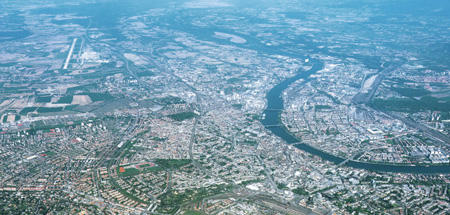MetroBasel 2006

Prof. Jacques Herzog, Prof. Pierre de Meuron,
Simon Hartmann, Manuel Herz, Ann-Sofi Rönnskog
Exercise type: “P”
Locations: Group work in Basel and in research location
Start: Wednesday, 25 October 2006, 10am at ETH Studio Basel, Spitalstrasse 8, 4056 Basel
We have to acknowledge that the master plan has failed. Once devised as a tool to project a vision of urbanity into the future and to steer a city’s development, the standard instruments of urbanism have degenerated into mere tracking devices, desperately trying to hold on to static models of the city. Based on a concept of the city as a sharply defined and well enclosed entity, with a strong preference for the plan view with a top-down approach, and preoccupied with the notion of a final state that the city is to achieve for it to be completed, the master plan has become a fragile Fata Morgana, unable to show a direction in the contemporary world and ever endangered by the multiple voices and actors impeding the city’s development. Today, as the future of cities is still decided by choosing zones on scaled maps, and as the destiny of an urban region is marked in colored patches on paper, corresponding to static use patterns, favoring the conventional, politely respecting existing street patterns, and slowly bringing the city to a grinding halt, the question arises whether fundamentally different approaches and tools should not be developed if the profession still wants to be taken seriously.
The region of MetroBasel is the region around the core city of Basel, including its suburbs, the urbanized agglomeration in the valleys to the south and the north, as well as more rural areas in its sphere of influence. It spans from the Jura in the south to the hills of the Black Forest in the northeast and the flatlands of the Alsace in the northwest. MetroBasel is the identity, forming a unit of the tri-national metropolitan region of Basel.
It is maybe in this metropolitan region of Basel that this failure becomes most apparent. The city and its thoroughly urbanized surrounding area of 800.000 inhabitants in total constitutes a hub of international acclaim, being one of the global leaders in the fields of art, the chemical industry, and the life sciences. In spite of its comparably small size, Basel has achieved a worldwide prominence and recognition. On the other hand, for a region spanning across three countries, spread over nine cantons or administrative regions and consisting of more than 200 communities, each having their own regulations, planning guidelines, and, at times conflicting, development aims, any coordinated effort for a regional plan and concerted urban development seems futile and is quickly dissolved in an intricate web of administrative obstacles and organizational incompatibilities. In spite of the geographical location and the international character of the region, urban master plans are still developed in a traditional fashion with little coordination between neighboring communities, triggering few, if any, cross-border visions of how the region should develop. While the planning department of the canton of Basel-City is currently working on formulating a new zoning plan – the first major revision of the city’s primary master plan in more than 30 years– ETH Studio Basel perceives this as an opportunity to develop an alternative proposal and to suggest a different methodology of how the city should develop in the future.
MetroBasel in 2028
The master plan has also failed with respect to incorporating and reacting to major developments in the sociopolitical arena. For architecture, and probably even more so for urbanism as the most visible and public fields of activities, a profession affecting virtually all of society directly, it is essential to take social, political, economical, and ecological aspects into consideration. However, this has not happened! It is valid to say that we are expecting major shifts in a number of those vital fields. At a time when the demographic structure of Europe is structurally changing, with the ageing population representing – for the first time in human history – a larger share of society and with an ever shrinking birthrate; at a time when the first forebodings of a fundamental climate change are being recognized; and at a time when the limits of growth and of resources, as predicted by the Club of Rome, are for the first time starting to have a direct impact on our daily lives, urbanism has to begin to account for those major shifts affecting our society in Western Europe as well as all over the globe.
PEOPLE: PROF. JACQUES HERZOG, PROF. PIERRE DE MEURON, SIMON HARTMANN, ANN-SOFI RÖNNSKOG, MANUEL HERZ

